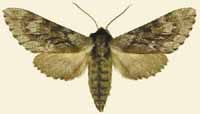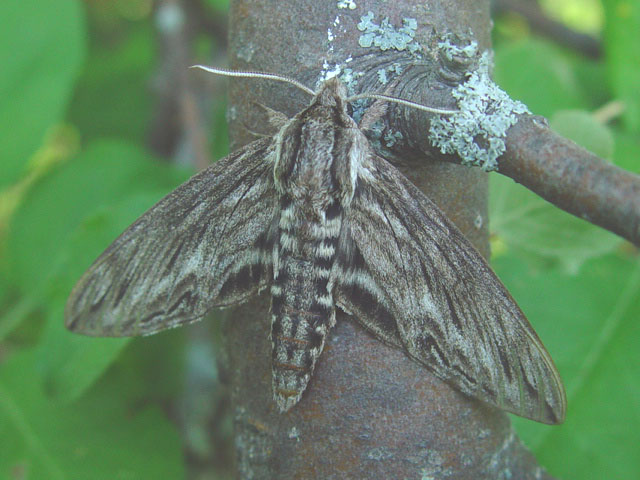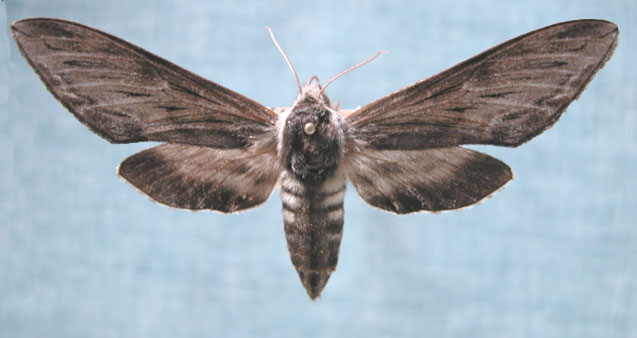Sphinginae subfamily
Sphingini tribe:
 |
Ceratomia amyntor
WO,
the Elm Sphinx or Four-horned Sphinx
The upperside of the forewing is brown with dark brown and white
markings including a white costal area near the wing base, dark
streaks along the veins, and a white spot in the cell.
Larvae feed on Elm (Ulmus), birch (Betula), basswood (Tilia), and cherry (Prunus). |
 |
It is named for the wavy lines on the forewings.
Note black and white collar separating thorax from abdomen. |
 |
Reported from northern Minnesota and central western Wisconisn,
it is present in Becker County as well. This is one we have on P.E.I.
|
Lapara bombycoides, June 27, 1979, Tom Middagh.
 |
Manduca quinquemaculata
WO the Five-spotted Hawkmoth
The moth abdomen usually has five but sometimes six pairs of yellow
bands. The upperside of the forewing is blurry brown and gray. If
you grow tomatoes, you might encounter it.
|

|
Sphinx canadensis
TM,
Sphinx canadensis, the Canadian Sphinx, is not common, and is not
often reported anywhere.
The absence of the white spot on each forewing and the more
brownish coloration serve to separate canadensis from S. poecila.
Larval hosts are white ash (Fraxinus americana) and blueberry
(Vaccinium).
|
Sphinx canadensis, June 5-6, 1979, Tom Middagh
 |
Sphinx chersis
WO, the Northern Ash Sphinx or Great Ash
Sphinx
The upperside of the forewing is soft dark gray to
blue-gray with a series of black dashes, one of which reaches the
wing tip.
Larval hosts are ash, lilac, privet, cherry, and quaking aspen.
|
 |
Forewings, long and slender,
are held close to the body when the moth is at rest.
We have them on P.E.I., but I do not see them frequently.
|
 |
The lower forewings are predominantly brownish-yellow with a fairly
wide dark bar along the inner margin. At rest the wings hug the body,
giving the moth a long slender look.
|
 |
If you have blueberries in the woods, then you might have the Poecila
Sphinx. They are pretty common here on Prince Edward Island, but
don't fly too far west of Wisconsin. |
Sphinx gordius June 23, 1978, probably
Sphinx poecila, Tom Middagh.
Smerinthini Tribe:
 |
This moth is also fairly widely reported to the east and south
and might be present.
This is the first Sphinx species I reared as a boy in New Jersey.
See the file for the female; she is different. |
Cressonia juglandis, June 25, 1979 Tom Middagh
 |
Pachysphinx modesta
WO,
the Modest Sphinx or Poplar Sphinx
This moth is also found in Canada. Moths have very heavy bodies.
Larvae eat poplar and willow. |
 |
Named for the dull grey-blue spot in the hindwing, this moth has a
very wide distribution.
I regularly see them on Prince Edward Island. |
 |
Named for the small eye-spot in the hindwing, this moth has a
very wide distribution.
I regularly see them on Prince Edward Island, and they are reported
as far south as Florida.
|
 |
Smerinthus cerisyi is found in the southern regions of all Canadian provinces and in northern border states. The One-eyed Sphinx is also found along
the U.S. west coast, eastward to the Rockies. At my home in Montague, P.E.I., Canada, they are quite common. |
Smerinthus cerisyi, June 29, 1979, Tom Middagh
 |
Smerinthus jamaicensis closely resembles Smerinthus cerisyi,
but jamaicensis is much smaller with larger blue patches on more
vibrant and deeper purple in the lower wings.
|
Macroglossinae subfamily
Dilophonotini tribe:
 |
Hemaris diffinis
TM, the Snowberry Clearwing or Bumblebee Moth
This moth is widely distributed and is confirmed by Tom Middagh
for Becker County.
|
See Hemaris comparison
Hemaris diffinis, June 26, 1979, Tom Middagh
 |
Hemaris thysbe
WO, the Hummingbird Clearwing
It is not difficult to see why many gardeners would mistake an Hemaris thysbe moth for a small hummingbird as it hovers, sipping nectar from flowers through a long feeding tube.
|
See Hemaris comparisons.
Macroglossini tribe:
 |
This day flier is widely distributed. If you have Virginia Creeper, you
probably have the Nessus Sphinx. Two bright, distinct, narrow yellow
bands are often visible on the abdomen.
|
 |
They are common in New Jersey and common
here on Prince Edward Island.
You will often see this species listed as Darapsa pholus,
especially in older literature. It is confirmed by Tom Middagh. |
Darapsa choerilus, June 25, 1979, Tom Middagh.
 |
Darapsa myron
WO, the Virginia Creeper Sphinx or the
Grapevine Sphinx
If you have the foodplants indicated in the common names, you
might have this species nearby. The lower wings are orange.
|
|
 |
Hyles gallii TM, the Bedstraw Hawk Moth
or Gallium Sphinx
This species is not reported in Minnesota on USGS, but Tom Middagh
confirms its presence in Becker and Nobles counties.
Some years I see them on P.E.I., some years, I do not.
|
Hyles gallii, July 7, 1976, Tom Middagh.
 |
Hyles lineata
WO, the White-lined Sphinx
This species is not recorded in Becker County.
It is a strong migrator from the south, however, and might appear late summer or early fall. |
|


